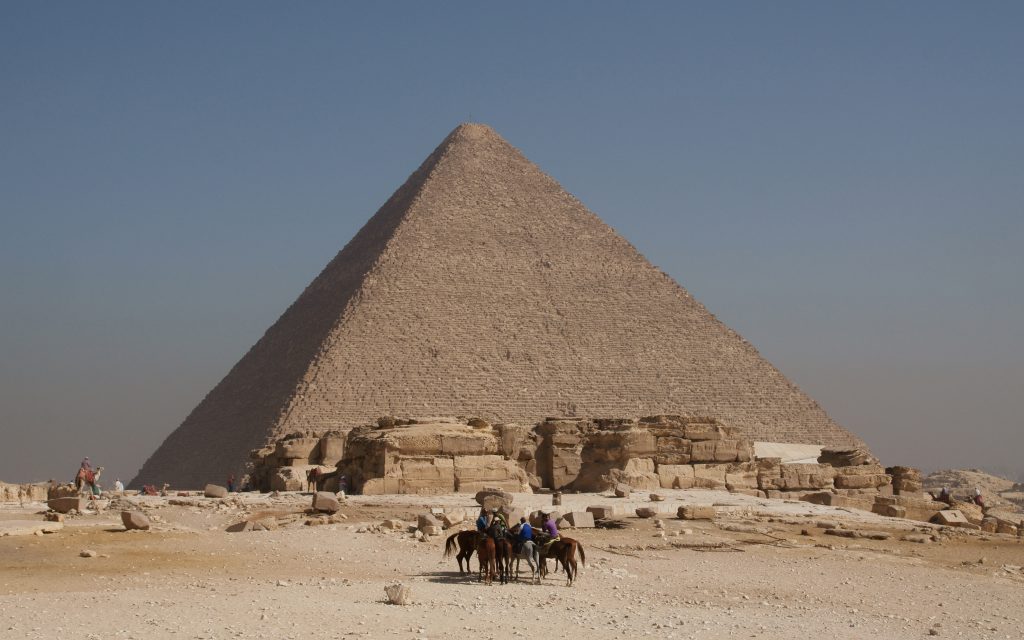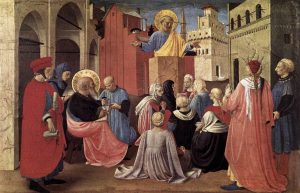The construction of the Great Pyramid of Giza has been a great mystery for many centuries. Recently, archaeologists believe that they have found evidence that suggests that it was not slaves, under the order of King Khufu, who were responsible for building the pyramid. With the discovery of nearby mastabas, there is now substantial evidence suggesting that normal villagers would periodically help construct the Great Pyramid, and they were motivated by their religious beliefs.1
King Khufu is considered one of the greatest rulers of his time, largely due to the elaborate pyramid he was able to create during his lifetime. He was known as a cruel and tyrannical leader, but was evidently powerful by being able to gather a large workforce and enough materials to construct the Great Pyramid, most of which is still intact today. According to Greek historian Herodotus, there had been around one hundred thousand slaves working through King Khufu’s reign. This was proved false in 1990 when the archaeologist Zahi Hawass discovered a town of mastabas near Giza.

These mastabas were rectangular mounds made of mud bricks. Eventually, they would stack some of them together to form pyramids, giving them the idea of the modern pyramid. The findings of many mastabas suggests that the workers were not slaves but were actually compensated in some form for their labor. They also discovered two miniature pyramids that held the remains of officials, such as supervisors, technicians, and craftsmen on the upper level, and other laborers on the lower level.2 The workforce consisted mainly of peasant farmers who would work during the fall and winter seasons. During that time period they were unable to work on their farms due to the seasonal overflow of the Nile River. This gave them an opportunity to continue working throughout the year. It was also a great way for the peasant farmers to get food, clothing, and shelter.3 Some laborers took part in a group called a phyle, which was a rotating group of workers who would work for a month. The king would collect surplus crops as well as other clothing to distribute to these workers, which he levied as a form of tax. Egyptologist such as Zahi Hawass and Mark Lehner now estimate that only about twenty to thirty thousand men were needed to build the Great Pyramid.
The construction of the pyramid was a communal project in which all Egyptians took part, including women as well as men. At the time, there were no machines or animals to help carry the loads of limestone and granite to the pyramids.4 Every block was handmade and crafted to fit perfectly alongside the other pieces. They cared greatly in their work and took pride in their accomplishments. Not only were they building the burial site for their king, but they were also taking part in the construction of a new and elaborate Egypt.
During Egypt’s Old Kingdom, when these pyramids were built, the kings were associated religiously to gods. They were seen as the living manifestation of the god Horus, the god of the sky. The god Horus was also the son of Osiris, who was the king of the underworld. Once the king would pass away he would become one with Horus.5 This helped motivate the laborers to continue building the pyramids. Most Egyptians at that time were very religious and spent their life preparing for what would come after death. They believed that by building the pyramid for their king, a descendant of Osiris, they would assure both their king and themselves a good afterlife. Because of this, they did not see their work as a continuous strain, but rather viewed it as an honor.
Overall, it was a very organized and coherent system that allowed everyone to partake in. It was beneficial not only to King Khufu, but to the entire Egyptian society as well. Jobs were created and many peasants received benefits of clothing and shelter from the enterprise. It united the Egyptian civilization and created magnificent pyramids that we can still visit today.
- Mastabas are burial mounds that were used to bury rulers and pharaohs, which later gave way to the idea of a pyramid. See Global Events : Milestone Events throughout History, Vol 1. Africa, Jennifer Stock, ed. (Detroit : Gale, Cengage Learning, 2014., 2014), 12. ↵
- Global Events : Milestone Events throughout History, Vol 1. Africa, Jennifer Stock, ed. (Detroit : Gale, Cengage Learning, 2014., 2014), 18. ↵
- The Oxford Companion to Archaeology (2 ed.), 2012, s.v. “Pyramids of Giza,” by Edward Bleiberg. ↵
- The Oxford Companion to Archaeology (2 ed.), 2012, s.v. “Pyramids of Giza,” by Edward Bleiberg. ↵
- Funk & Wagnalls New World Encyclopedia, 2016, s.v. “Horus”. ↵



87 comments
Andrea Degollado
Ive always been fascinated with pyramids because of what I read about them. This article is I truly interesting. I think it was interesting to read that what we all thought of how the pyramids were constructed was actually false, that in fact the pyramids weren’t built by slaves but by normal people.
Amanda Quiroz
I’ve always been attracted to pyramids. Maybe it’s the scenery or the shape that draws me into them. They obviously took a lot of work to construct. As it says in the article, I’m sure many villagers played a role in the construction of Giza’s pyramids. The history behind them and the pride that the villagers took in their hard work is pretty amazing.
Jacob Silva
It’s interesting to hear that most of the work to construct the pyramids was done entirely by the choice and freewill of local workers and not done by thousands of slaves like most theories have suggested. With the given rationale, it does make sense that the construction was volunteer based as their work was so that they could glorify Horus and ensure a good afterlife.
Antonio Coffee
Khufu seemed to be the one that benefited the most from this project but the project to build the Great Pyramid seemed to help everyone in Egypt that was willing to help it. It helped to provide work to do in the months that the citizens were unable to tend to their farms. This is very different from the story I learned about when I was in school. It is good to see that there are things that we keep discovering from this time in history.
Makenzie Santana
To this day pyramids are seen as one of the greatest forms of architecture, which creates quite the popularity for it to the world. A pyramid is even the name of a shape we learned in our early years of schooling being a child. So not only did the Egyptians create these monuments which resulted in something so popular to the modern day world, but it is also something so important to their faith during the ancient times.
Bianca-Rhae Jacquez
I didn’t know the significance that the pyramids had for the people during that time. The effort that these people put into building the pyramid is outstanding. i wonder how the citizens participating in the building process felt obligated to do it or did they do it to please the gods. This amazing monument has survived the test of time and it is still something people see and are in awe over.
Amariz Puerta
Learning about the pyramids was always interesting to me I never knew how much significance they held for ancient times. I always thought how brilliant they must have been to create such beautiful pyramids, and how they are still able to stand to this day and not deteriorate. I thought this article was very interesting in the creation of pyramids.
Danniella Villarreal
Even though many people know about the pyramid of Giza, not many people know about its creation and purpose. I think that it is great that new evidence has emerged on how the Pyramids may have been built. I think that this was a very interesting read and that even for a short article there was a lot of information and detail.
Ava Rodriguez
I have always wondered about where these pyramids came from, how they were created. Growing up hearing different stories of their creation, I always heard that aliens were responsible because apparently it is impossible for humans to create these gigantic pyramids. This was a very interesting article even though it was so short. It is so interesting how the pyramid is created.
Nadia Carrasco
Just having gone over this topic in class I found the great pyramid very interesting. Although there are tons of myths about how these actually occurred and came to be, this article does a great job at setting things straight. One thing I did not know and discovered from reading this article was that these were not constructed by slaves but normal people. It was actually seen as a privilege to build these amazing pyramids. Even though the article was so short I still believe it was a great read.